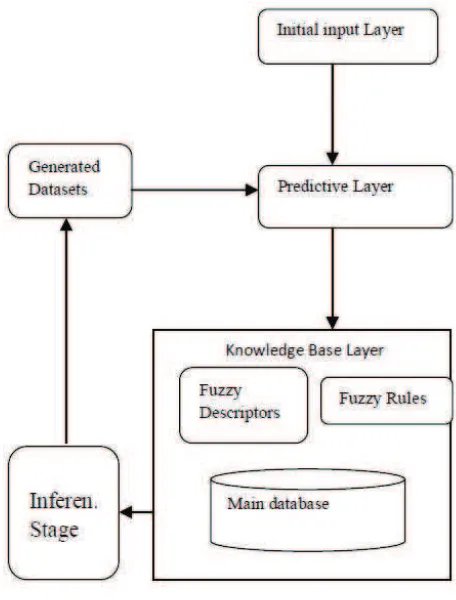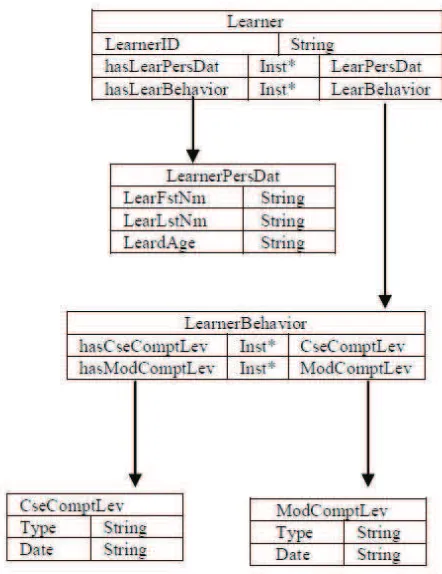Proposal for Ontology Based Approach to Fuzzy Student Model Design
Salisu Sani [email protected]
Teh N. M. Aris [email protected]
Department of Computer Science University Putra Malaysia 43400 Selangor, Malaysia
Abstract - Intelligent tutoring system (ITS) is a software system designed using artificial intelligent techniques (comprising of Fuzzy Logic, Neural-Networks, Bayesian networks, Ontology, Genetic Algorithms and Software Agents) to provide an adaptive and personalized tutoring suitable to each individual student based on his/her profile or characteristics. In this paper we intend to employ the use of Fuzzy logic and Ontology techniques to model the student’s learning behaviour with the aim of improving the learning path and increase the system’s adaptability. The use of fuzzy logic in this context is to enable the computational analysis of the student’s characteristics and learning behaviours in order to handle the uncertainty issues related to the student model design. Ontology is a vital tool for managing knowledge in a particular domain and is one of the recent techniques used to design the representation of student’s cognitive state.
Keywords- ITS; Fuzzy Logic; Ontology; Student Model
I. INTRODUCTION
The ITSs are software programs that provide support to the teaching and learning activities. The goal of these systems is to provide an automated alternative and modern way of changing the roles of a human teacher and improving it. An important characteristic of these intelligent tutoring systems is that they have the ability to make their instruction adaptive to cater for the needs and aspirations of each individual learner as much and better as human tutors can do. A standard architecture for these systems is made up of four basic components comprising of the student module (who to teach), the pedagogical module (how to teach), the domain module (what to teach) and the interface module (user-system interactive environment). One way to achieve the adaptation by ITS systems is through modelling the student module component of a typical ITS system. But the task of building an accurate student model is always faced with serious and challenging issues because the information available during initial interaction with the student is always explicit and such information can only gives a
partial representation of the expected student's knowledge state [1]. This partial representation of the knowledge state creates a major problem of having an inherent uncertainty in the student behaviour and current knowledge state. To deal with this uncertainty issue in student modelling, the Fuzzy logic technique is employed to provide an effective learning path for both the students and the tutors [5]. Effective use of the fuzzy logic technique can provide a means of diagnosing (improving the prediction accuracy) of the complete student behaviour and that can also equip the learning environment with intelligent reasoning abilities. The intelligent reasoning abilities can be used to generate pedagogical recommendations based on each individual student's profile and learning style. Both students and instructors in the learning environment can benefit through the implementation of the fuzzy logic technique by using the approach as a tool to encode knowledge in both structured and non structured form to solve pedagogical, adaptive and personalized recommendation issues [14].
II. RELATED LITERATURE
A. Overview of Student Model Design
The student model as one of the major components of a standard ITS system reflects what the system can infer about the student’s cognitive state. The goal of the student model design is to make any typical ITS system adaptive in order to specify learning path suitable to each user, monitor and manage user’s activities, identifying the user needs and preferences and to dynamically exploit both the student knowledge and domain knowledge to enhance the teaching and learning process [3]. Developing an adaptive learning system can sometimes be challenging due to the individual differences that exist among students. Every student has his/her peculiar needs, preferences and characteristics [12]. The student modeling technique proves to be a promising approach to effectively handle all those challenges not only within ITS systems but can be extended to most educational software applications that are intended to be adaptive and personalized.
2014 Fifth International Conference on Intelligent Systems, Modelling and Simulation
2166-0662/14 $31.00 © 2014 IEEE DOI 10.1109/ISMS.2014.14
B. Student Model Design
Recently, a number of works involving student model design have been developed with the aim of improving the intelligent tutoring system environment to be more adaptive and personalized to handle all issues related to student component of an ITS. Almost all the existing platforms use various artificial intelligence (AI) techniques to model the systems. Some uses single AI technique while others uses multiple AI techniques to achieve this objective. But regardless of which technique is employed, the idea remain the same i.e. they all aim at improving the teaching and learning process in any ITS. The table below gives a summary of some of the models describing their features and the techniques used to model them.
TABLE I. COMPARISON TABLE FOR FIVE EXISTING STUDENT MODELS
Model Objective Approach
PeRSIVA, 2013 Emp. Eval. of Stud. Model Oval+Ster+FL Grubisic , 2013 Stud. Model Ontology+BN Panagiotopolous, 2012 Sem. Rep.Stud. Model Ontology
Pena-Ayala, 2011 Predictive Stud. Model Fuzzy-Causal Conati, 2010 Stud. Model Bayesian Net
III. THE MODELING TECHNIQUES
A. Fuzzy Logic Technique in Student Modeling
A major issue of great concern in student modelling is the inherent uncertainty that exist due to lack of sufficient information with high degree of certainty to build this model. Tracking the student's activities in the system is one way of dealing with this issue because it helps in providing the sufficient information needed to build the student profile. But when these activities do not happen, then the only way to diagnose the situation is to apply efficient AI techniques that can provide the model with the required information having a higher degree of accuracy from the small and uncertain information available.
Every standard ITS system rely on the student model as a bench mark for decision making so if this uncertainty issue characterized with student model design is not properly handled, it may leads to having a poor and non adaptive instructional and learning environment. The fuzzy logic as a powerful computational intelligent technique is used to handle the uncertainty reasoning in student modelling [7]. The advantage of using fuzzy logic over other probabilistic techniques is very clear, the fuzzy logic theory can be used in a wide range of domains in which the information is incomplete or imprecise and because fuzzy reasoning is approximate in nature, it
creates an inference procedure that helps in drawing conclusions from a set fuzzy if-then rules and one or more conditions [2]. Moreover fuzzy logic is in the form of many valued function and this made fuzzy variables to have truth values ranging in degrees between 0 and 1. Unlike in most probabilistic and traditional logic approaches where every proposition in their premises is either true or false, fuzzy logic is widely employed to deal with issues of partial truth (inherent uncertainty) where the truth values may be ranging between completely true and completely false intervals in other words fuzzy logic is used to handle reasoning that is approximate rather than fixed and exact [8]. The figure below is the description of the conceptual fuzzy student architecture.
Fig.1. Conceptual Fuzzy student model architecture
B. Ontology Approach to Fuzzy Student Model Design
To the artificial intelligence community, ontology is defined as an explicit specification of conceptualization [13].The very essence of building ontology is to have a sophisticated knowledge representation about a target domain. In the general notion of semantic theory, ontology is used to encode meaning into a particular domain in order to facilitate the understanding of the relationship between entities in a domain [4]. The student model as a key component of intelligent tutoring systems use to hold information about the learner such as the
learning style, personal data as well as student’s academic status. For any ITS system to be very adaptive and capable of personalizing the teaching and learning process, this information within the student model must be managed effectively. Ontology is a powerful technique that is usually employed in student model design. There are two major reasons why ontology is used in student model design, first, ontology allows knowledge management and retrieval through the use of inference tools in the form of a reasoning kits to manipulate the information in the model. Secondly, ontology encourages the formal design of abstract concepts and properties in a manner that allow various tasks to re-use the concepts and properties effectively [6]. The figure 2 below is an example to show a small concept relation for an object student.
Fig. 2. Concept Relation Ontology for a learner entity
IV. CONCLUSION AND FEATURE WORK
The student model is the base for designing an effective and adaptive intelligent tutoring system. In this paper, we propose the use of two powerful computational intelligent techniques, fuzzy logic and ontology in order to build an effective student model component of ITS system. Both are suitable tools that have the manipulating power to improve the proposed model in order to enhance the intelligent tutoring environment. The basic idea behind student modelling is to make the intelligent
tutoring system functional and adaptive. Fuzzy logic is an effective tool for handling uncertainties issues that most students’ models are characterised with and the ontology on the other hand is one of the most recent tools for designing and managing knowledge in a particular domain. As feature enhancement, it is advisable to combine any or both techniques with any other artificial intelligent technique like data mining, genetic algorithms, neural networks to investigate what improvement that can course in improving the student model.
ACKNOWLEDGMENT
This article is written as my doctoral research thesis proposal funded by graduate school of University Putra Malaysia through my supervisor’s research grand allocation. I must acknowledge the assistance and scholarly guidance of my supervisor who also happens to be a co-author of this paper, the head of Computer Science and the dean faculty of Computer Science University Putra Malaysia.
REFERENCES
[1] C. Conati, "Bayesian student modeling", Advances in Intelligent Tutoring System Studies in Computational Intelligence, 2010.
[2] F. Masulli, "Introduction to fuzzy logic and systems”, 2010 [3] K. Chrystafiadi, & M. Virvou, "An empirical evaluation method of
a student model of an e-learning environment for computer programming", 2013.
[4] G. Ganapathy, & S. Sagayaraj, "To geneate the ontology from java source code", International journal of Advanced Computer Science and Applications, Vol.2 Issue 2. 2011.
[5] H. Fazlollahtabar & I. Mahdavi, "User/ Tutor optimal learning path in e-learning using comprehensive neuro fuzzy approach", Educational Research Review, Vol 4 Issue 2, 2009.
[6] D. Paneva, "Use of ontology-based student model in digital libraries", 2006.
[7] A. Zadeh, "Probability theory and fuzzy logic", 2002.
[8] V. Novak, I. Perfilieva, & J. Mockof, "Mathematical principles of fuzzy logic", The Springer International Series in Engineering and Computer Science, 1999.
[9] O. Nyakanen, "Fuzzy systems in student classification", 2006. [10] D. Paneva, "Ontology-based student modeling", In Proceedingof:
Fourth HABUSKA Workshop Semantic Web Wnowledge Technology Applicatin, 2007.
[11] I. Panagiotopolous, A. Kalou, P. Christor, & A. Kameas, "An ontology-based model for student representation in intelligent tutoring system", Artificial Intelligence Applications and Innovations 381: 296-305, Jan 2012
[12] Lo, Chan & Yeh. "Exploring influences of elementary school student’s learning motivation on web-based collaborative learning", US-China Education Review Vol. 6 613-299, 2012. [13] M. Obitko, "Introduction to ontologies and semantic web", 2007. [14] A. Grubisic, S. Stankov, I. Pereic, “Ontology based approach to
Bayesian student model” Expert system with application vol. 40 pp 5363-5371. (2013).
[15] A. Peña-Ayala, H. Sossa-Azuela, F. Cervantes-Pérez, “Predictive student model supported by fuzzy-causal knowledge and information, Expert system with application, 2011.

